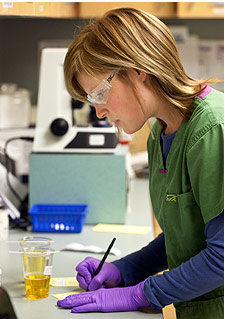Urologic Conditions
Prostate Cancer
Cancers of the kidney, bladder, prostate, and testicles are considered urologic cancers. Although not as commonly publicized as breast cancer, prostate cancer is the most commonly diagnosed cancer among men of all ethnicities and one of the leading causes of death when it goes undiagnosed. Bladder cancer is also one of the most common forms of cancer in both men and women, most commonly effecting men and women over 65. Testicular cancer, recently brought into the spotlight by pro-cyclist Lance Armstrong’s public battle with the disease, affects over 8,000 men annually but has a 95% survival rate if diagnosed early.
Prostate cancer is one of the most common cancers diagnosed in men over 50. The prostate is a small, semen-producing gland, about the size of a golf ball, located between the bladder and rectum. If diagnosed early and before it has spread beyond the prostate gland, prostate cancer can be successfully treated. Unfortunately, some prostate cancers are aggressive and can spread quickly, rapidly becoming much harder to treat. Because of this risk, it is important than men undergo regular screenings (the rectal exam and blood test know as a PSA test) to check the health of the prostate.
You can find more information about prostate cancer screening in this brochure from the American Urological Association.
If your doctor has reason to suspect a cancer in the prostate, he/she may perform a prostate biopsy to remove a piece of prostate tissue to test for cancer. This is a simple procedure that is performed by inserting a thin needle into the prostate to remove the tissue sample.
Risk Factors: Obesity, age, smoking, family history, and ethnicity
Surgical Procedures
Radical Prostatectomy:
This surgery is the removal of the entire prostate as well as surrounding lymph nodes and tissue. This surgery can be performed as an open surgery with an incision made in the lower abdominal wall or through an incision made in the perineal wall (the area between the scrotum and anus).
This procedure can also be performed robotically using the da Vinci Robot. For further information on this process, see the da Vinci website and their multi-media patient information.
Transurethral Resection of the Prostate (TURP)
This procedure removes tissue from the prostate by inserting a resectoscope (a cutting tool attached to a lighted tube) inserted through the urethra. This procedure is often performed to decrease pain or discomfort before more aggressive cancer treatment is performed.
Radiation and Hormone Therapy may also be performed.
For further information on these treatments, please see the website for the National Cancer Institute.

Bladder Conditions
Incontinence
Interstitial Cystitis
Vaginal Prolapse
Urinary Tract Infections
Stones
Male Anatomy
Circumcision
Vasectomy
Undescended Testes
Erectile Dysfunction
Urologic Cancers
Kidney Cancer
Bladder Cancer
Prostate Cancer
Testicular Cancer